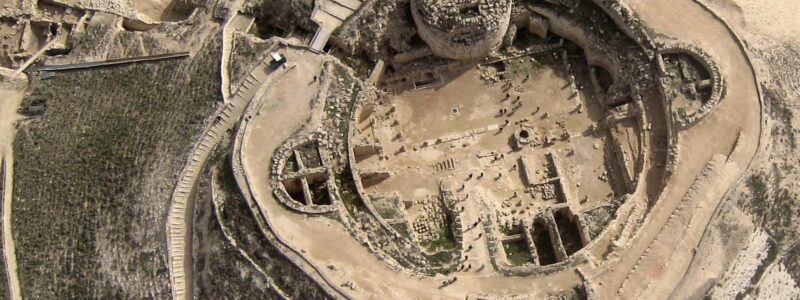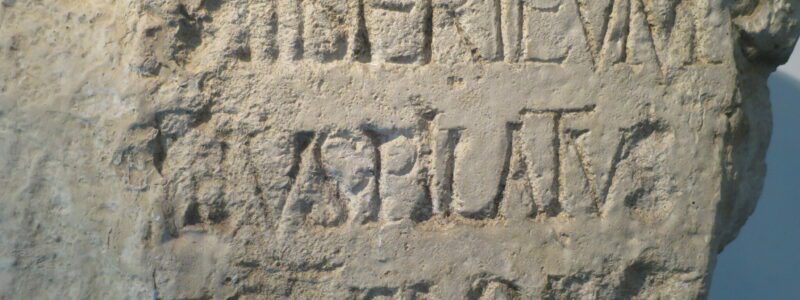Herod the Great’s Death Date
When Did Herod the Great Die – The Eclipse and The Eagle
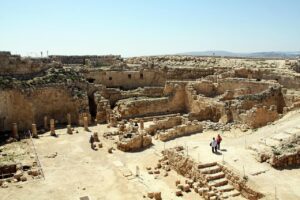
Herodium Ruins – By Own work – Own work, CC BY-SA 3.0, Link
The death date of Herod the Great is important because we know Herod was alive when Christ was born. Therefore, knowing Herod the Great’s death date will help determine the birth year of Christ.
Ultimately, the death date depends upon understanding astronomy because it provides the data necessary to pinpoint the dates ascribed by Josephus. Modern astronomy can determine the exact dates of many astronomical events such as lunar eclipses due to the orderly m movement of planets and their moons. There is a historical event described by Josephus, which helps to confirm the correct date.f
This date is important because historical events during this period are difficult to date and open to some controversy – that is not the case with a lunar eclipse date known for certainty. Historical events are so difficult to ascertain during the decade of 4 BC to 6 AD called the “dark decade.” Rather than total speculation, we can find quantitative confirmation of the most likely date for the eclipse referred to by Josephus that occurred just before Herod’s death.

Lunar eclipse or a “Blood Moon.”
Ancient Palestine saw many eclipses between 6 BC and 1 BC, any of which candidates for this all-important event. However, trying to determine the most likely candidate requires further confirmation from historical events.
Help from Josephus. There were four lunar eclipses visible in Palestine between 6 BC and 1 BC; these are listed here:
- 5 BC – March 23 – Total eclipse. Central at 8:30 PM (elapsed time between eclipse and Passover – 29 days).
- 5 BC – September 15 – Total eclipse. Central at 10:30 PM (elapsed time between eclipse and Passover – seven months)
- 4 BC – March 13. Partial eclipse. Central at 2:20 AM (elapsed time between eclipse and Passover: 29 days)
- 1 BC – January 10. Total Eclipse. Central at 1:00 AM (elapsed time between eclipse and Passover: Twelve and a half weeks)
The March 13, 4 BC eclipse and Herod the Great’s death date. This eclipse is the one most historians and theologians have accepted as the Josephus eclipse. It seems a good candidate because it occurred about 29 days before the next Passover.
The problem, however, is that it is impossible to squeeze all the historical events we know happened between Herod’s death and the next Passover into that 29-day interval. We know Herod was sick and suffered a painful, slowly progressive illness before his death. We know, for example, that part of Herod’s body was putrefied and bred worms (probably maggots)
Josephus said these events happened between his death and the next Passover;
- He is taking a round-trip to warm baths 16 Km away.
- He orders all-important men in all villages to come (120-30 Km).
- His son Antipas is executed, and Herod dies 5 days later.
- There is a magnificent funeral, and the body is carried 37 Km.
- A 7-day mourning starts, followed by a funeral feast.
Historian Ernest Martin showed that it would be impossible for all these to have occurred in less than 54 days, which is too long a timeframe for the March 13, 4 BC eclipse. Furthermore, the March eclipse was only a partial eclipse that occurred late at night and would seem unlikely to have even been considered very important. On the other hand, the total eclipse of January 10, 1 BC, was visible in the early evening and would have been much more spectacular to watch.
The Sickness, Death, and Funeral of Herod the Great
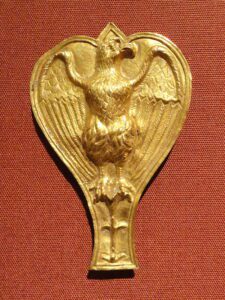
Roman Eagle – By Daderot – Own work, CC0, Link
King Herod decided it would be a good idea to honor Rome and erect a Roman eagle at the entrance to the Temple in Jerusalem. This error in judgement by failing to recognize the sensitivities of Jews concerning their Temple caused only grief for Herod.
The religious Jews considered placing a Roman eagle on the Temple to be a sacrilege and were deeply offended by Herod’s actions. Judas and Matthias who were two respected Jewish teachers of the law, encouraged young Jewish men to cut down the eagle. Unfortunately, the men were caught red-handed by the Roman legion and arrested.
Herod was insulted that the Jews would directly challenging his decision to place the eagle on the Temple. Herod was enraged and decided to put them all on trial for their life. Herod had the instigators, including the two respected sages Judas and Matthias, bound and taken to Jericho. He then called for the Sanhedrin to convene a trial that he would oversee to be sure they arrived at the “correct” verdict.
Josephus tries to compare their deed to a definitive moment in Jewish history when decades previously, the Maccabaean Martyr’s refusal to give in to another tyrannical ruler, Antiochus Epiphanes. Antiochus had offered a pig to Zeus on the Temple alter thoroughly angering the devout Jewish population. By pairing the desecration of the Temple with a pig sacrifice with the desecration of the Temple by a Roma eagle, the defendants were trying to appeal to the Sanhedrin’s sense of pride in their culture.
Herod was not impressed with their defense and insisted the Jewish rabbis receive the ultimate punishment. Accordingly, the court sentenced the rabbis to be burned alive, while the young men received lesser penalties.
Herod would die shortly after this trial took place; there was little sorrow in Jerusalem after his death.
Herod’s Funeral
Herod’s funeral ceremony had to occur between his death (January 28th) and the Jewish Passover during 1 B.C. (April 6th). It turns out that Herod insisted on a very elaborate funeral procession that would take weeks to perform but which could easily be done during this time period.
Herod the Great’s death date is helped by understanding the time required to get him buried in a manner consistent with his wishes.
First, Herod’s body was embalmed in honey as a preservative; 500 domestics were required for this procedure, and went with the funeral to reapply spices as required to overcome the smell as his body decomposed,
–Josephus further remarks concerning the funeral procession,
The body was carried upon a golden bier, embroidered with very precious stones of great variety, and the body was covered with purple, as was the body itself: he had a diadem upon his head, and above it a crown of gold; he also had a scepter in his right hand. About the bier were his sons and his numerous relations; next to these the soldiers, distinguished according to their several countries and denominations; and they were put in the following order: first of all, went his guards, then the band of Thracians, after them the Germans, next came the band of Galatians, everyone in their habiliments of war; and behind these marched the whole army, in the same manner as they used to go out to war, and as they used to be put in the array by their muster-masters and centurions;
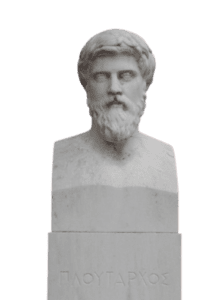
Plutarch – By Deedman22 – Own work, CC BY-SA 4.0, Link
Plutarch, another Roman historian, wrote that the stately procession was in no hurry to get to the burial place but rather went in a stately, respectful manner exactly 8 stades (a Roman mile) a day. Furthermore, Josephus indicates that all the military personnel was fully dressed in war uniform while marching in a formation every day. The journey from Jericho to Jerusalem and then to the burial place (Herodium) was 25 miles; furthermore, the funeral procession traveling through Jewish territory would not travel during three Sabbath days meaning the entire trip would require at least 28 days.
In addition, there was a 30-day mourning period which Josephus indicates also occurred before the Passover according to Jewish custom after the death of an important person (Numbers 20:29, Deut. 34:8) called the Sheloshim. Additionally, there was another seven-day period of mourning for close relatives (Numbers 19:14). While the public and private mourning periods can overlap either completely or partially depending upon when the burial took place, an overlap would have been unlikely in the case of Herod.
Josephus relates other official functions that also took place after the funeral of Herod and before the Passover. For example, Archelaus, the son of Herod, who then became King, made changes to the duties of army personnel, conferred promotions, liberated prisoners detained by his father, and heard many lawsuits.
All of these activities – the slow funeral march, 30-day public and 7-day private mourning periods, and subsequent official activities of his son Archelaus, all took multiple weeks to accomplish and would be impossible to do during the 20-day time interval between the partial lung eclipse and Passover of 4 B.C.; rather, the much longer 12-week period between the full lunar eclipse and Passover of 1 B.C. would seem more likely.
Historical events and lunar eclipse associated with the death of Herod the Great seem to best place Herod’s death in 1 B.C. But there is additional corroborating historical data regarding Augustus Caesar and the taxation of the Roman world.
That All The World Should be Taxed

All the World Should be Taxed. Image by Nattanan Kanchanaprat from Pixabay
One of the most familiar Biblical stories is how Joseph took his wife Mary to Bethlehem and found no room at the inn. The family was then required to spend the night in an animal stall. Mary gave birth to the baby Jesus and placed him in an animal feeding trough filled with hay. Likewise, the King of the Universe humbled himself to spend his first night on earth as an infant in a filthy animal stall while sleeping on hay in an animal feeder.
The exact reason why the family had to travel the long trip with a pregnant woman to Bethlehem in the first place has been a matter of conjecture for centuries. Part of the problem with coming up with the answer has been timing – there seemed to be no good reason if Christ was born before 4 BC, as was thought to be the case until recently.
Since we now believe that Herod died early in the year 1 BC, the reason for the family to come to Bethlehem becomes apparent. There were several censuses taken during the reign of Emperor Augustus Caesar. The first census was apparently performed during 8 BC as documented by a temple to Augustus at Ankara in Turkey. This first census was a tax call that was only relevant to Roman citizens and not to the Jews living in Galilee (who were not Roman citizens.
Another census and an oath of allegiance would have involved everybody living in Roman territory (including all the Jews) during 3/2 BC. This oath of allegiance was pronounced as a special honor given to Augustus Caesar by the Roman Senate, whereby he was proclaimed the Father of the Country.
Joseph and Mary were both direct descendants of King David (as documented in the Gospel of Matthew) and would have been required to go to their ancestral city, which in their case was Bethlehem (the “city of David”). Josephus recorded that nearly 6000 Pharisees refused to take this oath approximately one year before Herod died as pledging loyalty to Rome would have been blasphemy.
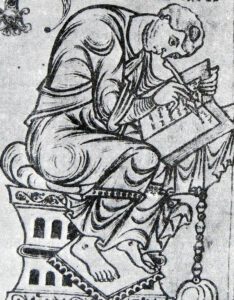
Orosius – By Unknown author – Códice de Saint-Epure., Public Domain, Link
Orosius – a historian of the 5th century, links this census with the enrollment of Mary and Joseph,
“[Augustus] ordered that a census be taken of each province everywhere and that all men be enrolled. So at that time, Christ was born and was entered on the Roman census list as soon as he was born. This is the earliest and most famous public acknowledgment which marked Caesar as the first of all men and the Romans as lords of the world…that first and greatest census was taken, since in this one name of Caesar all the peoples of the great nations took oath, and at the same time through the participation in the census, were made part of one society.”
Augustus’ decree required all adults to pledge their goodwill to Caesar, and the complete enrollment was presented to him as part of the celebration of his special honor.
The Mystery of Quirinius. Luke notes in his Gospel,
In those days Caesar Augustus issued a decree that a census should be taken of the entire Roman world. (This was the first census that took place while Quirinius was governor of Syria.) And everyone went to their own town to register. (Luke 2:1-3).
The problem is that Quirinius did not become governor until after 6 AD, while the census took place in 2/3 BD. But as it turns out, Quirinius (also known as Quintilius) was provisional governor of Syria from 2 BC to 1 AD. Historian Paul Finch notes,
But who was the actual governor at this time? The early Christian apologist Tertullian living in the late second century, who was by profession a lawyer and well acquainted with Roman governmental affairs, said that the census that brought Joseph and Mary to Bethlehem was conducted when Sentius Saturninus was governor of Syria (Answer to the Jews, ch. 8). What’s more, he said it occurred in the 41st year of Augustus answering to 3/2 B.C. Indeed, the early Christian sources were nearly united in stating that Jesus was born in 3/2 B.C. The list includes Clement of Alexandria, Origin, Africanus, Hippolytus of Rome, Hippolytus of Thebes, and Cassiodorus Senator (Finegan, Handbook of Biblical Chronology, p. 229). This is strong testimony indeed because these sources were able to consult the vast libraries at their disposal which modern historians no longer have access to. But the next best thing to having access to these vital records is to accept the testimony of those who did! Modern scholarship has disgraced itself in an utter unprofessional way by ignoring this testimony in favor of our present fragmentary knowledge for this period.
Quirinius being governor during 3/2 BC means what Luke wrote would be correct for the years when the actual governor of Syria was absent.
Testimony of Church Fathers. The ancient Church Fathers placed Christ’s birth at 3/2 BC, supporting the timeline noted above. This would not be consistent with the conventional determination of Herod the Great’s death date as 4 BC. However, as Finch notes in the above quotation, these Christian theologians lived in a time when Roman records were still available for review and were likely exposed to information that is no longer available.
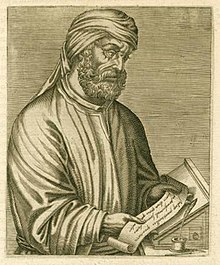
Tertullian – Public Domain, Link
Both Irenaeus and Tertullian place Christ’s birth to the 41st years of Augustus’ reign. If the date of the start of Augustus’ reign is the date of his elevation to the consulship in August 43, then the year intended is 2 BC. Tertullian also links Christ’s birth date as being 28 years after the death of Cleopatra and 15 years before the death of August. Since Cleopatra died in August 30 BC and Augustus died in August 14 AD, the date of Christ’s birth is confirmed in about 2 BC.
Summary of Herod the Great’s Death Date
Herod the Great was one of the most despotic rulers of the ancient world; paranoid that somebody in his family would kill him, he had most of his sons murdered.
His life is important to Christian historians because it helps to date Christ’s birth and helps to confirm the Christian narrative. Far from being a quaint story told at Christmastime, ancient historians and astronomical lunar eclipse data confirm Christ was born in 3/2 BC.
Remarkably, this date would make Christ about 30 years old at the time of the start of his ministry – a time when ancient Jewish rabbis could begin teaching. This dating would also work with our Crucifixion date of 33 AD – it all fits together.
The historical confirmation of Scripture helps to support its accurate historicity and support the entire Christian narrative.
Once again, Scripture is supported as being an accurate representation of actual historical events, placed in real-time, and supported by ancient secular historians. Thus, we can have confidence in the Scriptures as being accurate about the gospel message as well.
References to Herod the Great’s Death Date
Featured image of Herodium Ruins – By Own work – Own work, CC BY-SA 3.0, https://commons.wikimedia.org/w/index.php?curid=18905769

